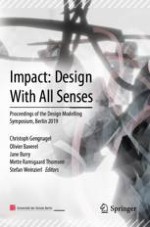2020 | OriginalPaper | Chapter
Repetitive Structures
Authors : Eike Schling, Rainer Barthel
Published in: Impact: Design With All Senses
Publisher: Springer International Publishing
Activate our intelligent search to find suitable subject content or patents.
Select sections of text to find matching patents with Artificial Intelligence. powered by
Select sections of text to find additional relevant content using AI-assisted search. powered by
